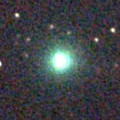
|
It brightened very rapidly. Now it is very bright as 9.2 mag (Oct. 9, Chris Wyatt). It stays bright as 8-9 mag until October. The condition is bad in this apparition. In the Southern Hemisphere, it stays observable after this while the comet will be fading. But it stays locating low. It is not observable after this in the Northern Hemisphere.
Date(TT) R.A. (2000) Decl. Delta r Elong. m1 Best Time(A, h)
Oct. 16 11 29.90 -31 42.6 1.946 1.265 34 9.2 4:42 (303, -9)
Oct. 23 11 55.74 -35 39.7 2.003 1.325 35 9.6 4:48 (307,-10)
|
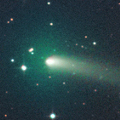
|
Now it is bright as 10.1 mag (Oct. 13, Marco Goiato). It will brighten up to 9 mag, and will be observable in good condition in winter.
Date(TT) R.A. (2000) Decl. Delta r Elong. m1 Best Time(A, h)
Oct. 16 6 7.23 24 33.6 0.447 1.230 110 9.8 4:29 ( 0, 80)
Oct. 23 6 38.90 25 31.4 0.433 1.217 110 9.6 4:33 ( 0, 80)
|
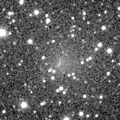
|
Now it is bright as 11.6 mag (Oct. 4, Carlos Labordena). It is observable at 10 mag in good condition from October to December. In the Northern Hemisphere, it locates somewhat low at the high light.
Date(TT) R.A. (2000) Decl. Delta r Elong. m1 Best Time(A, h)
Oct. 16 19 41.27 -30 51.3 0.985 1.393 89 10.1 18:48 ( 10, 23)
Oct. 23 20 8.99 -31 35.2 1.038 1.414 88 9.9 18:40 ( 8, 23)
|
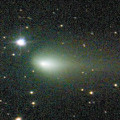
|
Now it is bright as 10.8 mag (Oct. 14, Osamu Miyazaki). It stays observable at 10-11 mag in excellent condition from summer to autumn.
Date(TT) R.A. (2000) Decl. Delta r Elong. m1 Best Time(A, h)
Oct. 16 6 28.94 14 4.7 1.094 1.663 105 10.3 4:42 (354, 69)
Oct. 23 6 38.80 12 59.3 1.061 1.680 109 10.4 4:33 ( 0, 68)
|
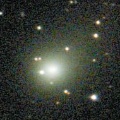
|
Now it is 10.5 mag (Oct. 14, Osamu Miyazaki). It stays bright as 10 mag until spring for a long time. In the Northern Hemisphere, it stays observable in good condition for a long time. In the Southern Hemisphere, it locates extremely low until November.
Date(TT) R.A. (2000) Decl. Delta r Elong. m1 Best Time(A, h)
Oct. 16 7 40.67 41 52.6 3.454 3.639 92 10.6 4:42 (241, 73)
Oct. 23 7 44.00 41 17.0 3.343 3.626 98 10.5 4:48 (234, 78)
|
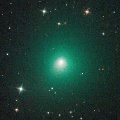
|
It brightened up to 9.5 mag in early summer (June 27, Marco Goiato). Now it is fading. But it is bright as 11.4 mag still now (Oct. 4, Carlos Labordena). It will be unobservable soon in the Northern Hemisphere, or in November in the Southern Hemisphere.
Date(TT) R.A. (2000) Decl. Delta r Elong. m1 Best Time(A, h)
Oct. 16 16 49.19 -27 8.4 2.833 2.352 51 11.6 18:48 ( 47, 9)
Oct. 23 17 4.58 -28 21.7 2.932 2.392 48 11.8 18:40 ( 47, 8)
|
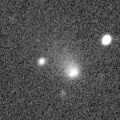
|
Now it is 12.3 mag (Oct. 10, Michael Jager). It will approach to Earth down to 0.2 a.u. in December, and it is expected to brighten up to 4 mag. In the Northern Hemisphere, it stays observable in good condition for a long time until December while the comet is brightening gradually. In the Southern Hemisphere, it is not observable until mid December.
Date(TT) R.A. (2000) Decl. Delta r Elong. m1 Best Time(A, h)
Oct. 16 11 32.84 36 13.8 2.048 1.635 51 12.2 4:42 (244, 28)
Oct. 23 11 40.30 35 36.8 1.844 1.529 55 11.7 4:48 (247, 33)
|
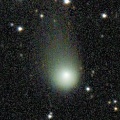
|
Now it is bright as 11.6 mag (Oct. 3, Osamu Miyazaki). It is expected to be observable at 5-6 mag for a long time from 2022 to 2023. In the Northern Hemisphere, it is not observable at the high light from 2022 autumn to 2023 summer. In the Southern Hemisphere, it stays low for a while. But it will be observable in good condition at the high light.
Date(TT) R.A. (2000) Decl. Delta r Elong. m1 Best Time(A, h)
Oct. 16 17 5.04 23 30.9 5.448 5.074 63 11.7 18:48 ( 89, 45)
Oct. 23 17 8.31 22 14.2 5.451 5.013 59 11.7 18:40 ( 90, 41)
|
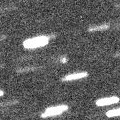
|
Major outburst occured on Oct. 17. Now it is very bright as 11.9 mag (Oct. 17, Francois Kugel). It stays observable in the evening sky for a while.
Date(TT) R.A. (2000) Decl. Delta r Elong. m1 Best Time(A, h)
Oct. 16 18 3.06 -20 59.1 1.821 1.720 68 16.5 18:48 ( 37, 24)
Oct. 23 18 22.32 -21 1.7 1.872 1.721 65 11.8 18:40 ( 37, 24)
|
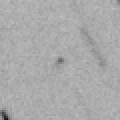
|
Now it is 13.4 mag (Oct. 8, Chris Wyatt). It will brighten rapidly up to 9 mag in winter. It will be observable in good condition. In the Southern Hemisphere, it is observable in excellent condition. In the Northren Hemisphere, it is not observable until November.
Date(TT) R.A. (2000) Decl. Delta r Elong. m1 Best Time(A, h)
Oct. 16 23 10.64 -56 40.6 1.210 1.802 109 12.3 21:30 ( 0, -1)
Oct. 23 23 5.98 -54 54.9 1.202 1.752 105 12.0 20:58 ( 0, 0)
|
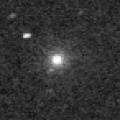
|
It was observed at 9-10 mag from late July to early August. Now it is not observable. It will appear in the morning sky in December, but it will be fainter than 15 mag at that time.
Date(TT) R.A. (2000) Decl. Delta r Elong. m1 Best Time(A, h)
Oct. 16 13 28.85 -2 43.9 2.377 1.390 6 12.3 18:48 ( 96,-14)
Oct. 23 13 46.30 -5 25.3 2.471 1.485 5 12.7 4:48 (267,-14)
|
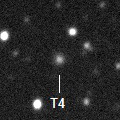
|
Now it is 13.8 mag (Oct. 9, Chris Wyatt). It is expected to brighten up to 11.5 mag in 2022. In the Southern Hemisphere, it stas observable in good condition for a long time, although it became extremely low temporarily from August to September. It is getting observable also in the Northern Hemisphere.
Date(TT) R.A. (2000) Decl. Delta r Elong. m1 Best Time(A, h)
Oct. 16 10 58.57 -24 58.8 5.414 4.670 38 13.2 4:42 (302, 1)
Oct. 23 11 5.82 -25 26.2 5.349 4.646 41 13.1 4:48 (306, 5)
|
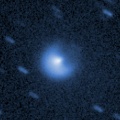
|
Major outburst occured on Sept. 25. Now it is very bright as 10.8 mag (Oct. 14, Osamu Miyazaki).
Date(TT) R.A. (2000) Decl. Delta r Elong. m1 Best Time(A, h)
Oct. 16 4 56.48 32 8.3 5.286 5.922 125 13.4 3:19 ( 0, 87)
Oct. 23 4 54.89 32 12.9 5.204 5.924 132 13.4 2:50 ( 0, 87)
|

|
It brightened up to 12.3 mag from spring to summer (June 15, Marco Goiato). Now it is fading. It has already faded down to 13.8 mag (Sept. 8, Chris Wyatt). Now it is not observable. It will be observable again at 14 mag in November in the Northern Hemisphere, or in January in the Southern Hemisphere.
Date(TT) R.A. (2000) Decl. Delta r Elong. m1 Best Time(A, h)
Oct. 16 14 1.26 -2 19.1 4.723 3.751 11 13.8 18:48 ( 92, -7)
Oct. 23 14 4.53 -1 59.4 4.756 3.780 10 13.9 18:40 ( 94,-10)
|
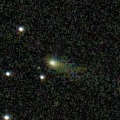
|
Now it is 13.1 mag (Oct. 8, Toshihiko Ikemura, Hirohisa Sato). It is observable at 14 mag in excellent condition in autumn.
Date(TT) R.A. (2000) Decl. Delta r Elong. m1 Best Time(A, h)
Oct. 16 0 21.52 -2 28.2 0.741 1.715 160 14.1 22:41 ( 0, 53)
Oct. 23 0 21.99 -3 7.8 0.754 1.705 153 14.0 22:14 ( 0, 52)
|
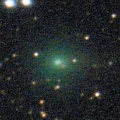
|
It brightened very rapidly up to 10.7 mag in July (July 20, Osamu Miyazaki). Now it is fading. It has already faded down to 15.9 mag (Oct. 8, Toshihiko Ikemura, Hirohisa Sato). It stays observable in the morning sky for a long time.
Date(TT) R.A. (2000) Decl. Delta r Elong. m1 Best Time(A, h)
Oct. 16 8 35.03 25 57.8 1.496 1.618 78 14.2 4:42 (278, 60)
Oct. 23 8 44.68 25 50.8 1.487 1.684 82 14.6 4:48 (283, 64)
|
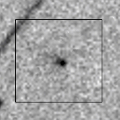
|
Now it is not observable. In the Southern Hemisphere, it will appear in the morning sky at 11 mag in late January, then it stays observable at 11 mag until June. In the Northern Hemisphere, it will appear in the morning sky in December, but it stays locating extremely low for a long time.
Date(TT) R.A. (2000) Decl. Delta r Elong. m1 Best Time(A, h)
Oct. 16 13 39.35 -6 51.5 3.132 2.139 4 14.7 18:48 ( 91,-14)
Oct. 23 13 53.81 -8 14.2 3.090 2.098 3 14.5 18:40 ( 91,-16)
|
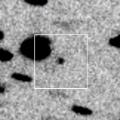
|
It will brighten up to 12 mag from winter to spring. Now it is not observable. In the Northern Hemisphere, it will appear in the morning sky at 14 mag in November. In the Southern Hemisphere, it is not observable until January.
Date(TT) R.A. (2000) Decl. Delta r Elong. m1 Best Time(A, h)
Oct. 16 12 27.57 4 31.5 2.938 2.024 19 15.0 4:42 (265, 1)
Oct. 23 12 42.65 2 48.8 2.874 1.986 21 14.8 4:48 (269, 4)
|

|
Now it is 14.7 mag (Oct. 9, Chris Wyatt). It stays 14-15 mag until the end of 2021. In the Southern Hemisphere, it stays observable in good condition for a long time. It locates low in the Northern Hemisphere.
Date(TT) R.A. (2000) Decl. Delta r Elong. m1 Best Time(A, h)
Oct. 16 22 28.85 -27 37.8 4.011 4.646 124 15.0 20:48 ( 0, 28)
Oct. 23 22 26.27 -26 34.0 4.120 4.667 117 15.1 20:18 ( 0, 29)
|
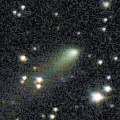
|
Now it is 14.3 mag (Oct. 1, Toshihiko Ikemura, Hirohisa Sato). It will be fading after this. In the Northern Hemisphere, it stays observable in good condition for a long time, although it becomes extremely low temporarily in November. In the Southern Hemisphere, it is not observable until late January.
Date(TT) R.A. (2000) Decl. Delta r Elong. m1 Best Time(A, h)
Oct. 16 16 7.02 18 47.9 2.837 2.306 48 15.0 18:48 ( 92, 31)
Oct. 23 16 6.41 18 8.0 2.913 2.315 44 15.1 18:40 ( 94, 26)
|

|
Now it is 14.9 mag (Oct. 6, Chris Wyatt). It stays 13-14 mag from 2020 to 2021. It will be observable in good condition after this in the Southern Hemisphere. It locates low in the Northern Hemisphere.
Date(TT) R.A. (2000) Decl. Delta r Elong. m1 Best Time(A, h)
Oct. 16 19 16.82 -34 16.1 3.071 3.123 83 15.1 18:48 ( 15, 19)
Oct. 23 19 24.92 -33 55.6 3.178 3.137 78 15.2 18:40 ( 18, 19)
|
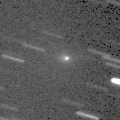
|
Now it is 14.3 mag (Oct. 4, Michael Jager). It stays 15 mag until November. It will be observable in excellent condition in the Northern Hemisphere. It locates somewhat low in the Southern Hemisphere.
Date(TT) R.A. (2000) Decl. Delta r Elong. m1 Best Time(A, h)
Oct. 16 6 43.69 27 16.0 1.171 1.698 102 15.1 4:42 (325, 81)
Oct. 23 6 55.51 28 20.0 1.132 1.714 107 15.1 4:48 (355, 83)
|
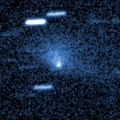
|
It brightened up to 10.1 mag in spring (Apr. 10, Marco Goiato). Now it is fading. It has already faded down to 15.3 mag (Oct. 14, Sandor Szabo). It stays observable in good condition for a long time after this while the comet will fading.
Date(TT) R.A. (2000) Decl. Delta r Elong. m1 Best Time(A, h)
Oct. 16 4 52.57 6 29.9 1.644 2.392 128 15.1 3:15 ( 0, 62)
Oct. 23 4 48.67 6 7.2 1.624 2.435 135 15.2 2:44 ( 0, 61)
|
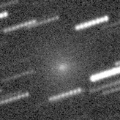
|
Bright new periodic comet. Now it is 14.5 mag (Oct. 8, Toshihiko Ikemura, Hirohisa Sato). It stays observable in good condition for a long time. It stays 14-15 mag until November. Juan Jose Gonzalez reported it is very bright as 11.8 mag on Oct. 7.
Date(TT) R.A. (2000) Decl. Delta r Elong. m1 Best Time(A, h)
Oct. 16 9 24.88 8 32.8 1.500 1.354 61 15.2 4:42 (291, 40)
Oct. 23 9 42.09 6 13.7 1.499 1.390 64 15.3 4:48 (297, 42)
|

|
Now it is 16.0 mag (Aug. 16, iTelescope Observatory, Siding Spring). It is expected to brighten up to 13 mag in 2022. In the Southern Hemisphere, it stays observable in good condition for a long time, although it becomes extremely low temporarily from September to October. In the Northern Hemisphere, it is not observable for a while.
Date(TT) R.A. (2000) Decl. Delta r Elong. m1 Best Time(A, h)
Oct. 16 12 28.59 -31 45.4 4.771 3.902 26 15.3 4:42 (296,-19)
Oct. 23 12 32.00 -33 8.6 4.712 3.864 28 15.2 4:48 (301,-15)
|

|
Now it is 15.9 mag (Oct. 8, Thomas Lehmann). It stays at 14-15 mag for a long time from 2021 to 2022. It will be unobservable from November to January.
Date(TT) R.A. (2000) Decl. Delta r Elong. m1 Best Time(A, h)
Oct. 16 16 25.47 -20 7.9 5.645 4.995 45 15.2 18:48 ( 56, 10)
Oct. 23 16 27.82 -20 58.5 5.727 4.994 39 15.3 18:40 ( 58, 7)
|

|
Now it is 14.9 mag (Oct. 9, Chris Wyatt). It was expected to brighten up to 13 mag from spring to summer. But actually, it is fainter than originally expected. It will be fading slowly after this. In the Southern Hemisphere, it stays observable in good condition for a long time. In the Northern Hemisphere, it is not observable until July in 2022.
Date(TT) R.A. (2000) Decl. Delta r Elong. m1 Best Time(A, h)
Oct. 16 21 17.79 -76 21.4 3.645 3.744 87 15.2 19:40 ( 0,-21)
Oct. 23 21 28.15 -74 31.4 3.708 3.762 85 15.3 19:22 ( 0,-19)
|
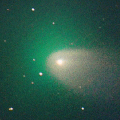
|
It brightened up to 9.7 mag in June (June 4, Michael Jager). Now it is fading. It has already faded down to 14.1 mag (Sept. 11, Chris Wyatt). In the Southern Hemisphere, it stays observable in excellent condition for a long time. In the Northern Hemisphere, it becomes extremely low after this.
Date(TT) R.A. (2000) Decl. Delta r Elong. m1 Best Time(A, h)
Oct. 16 23 15.58 -43 24.8 1.327 2.022 120 15.4 21:35 ( 0, 12)
Oct. 23 23 16.79 -41 21.5 1.430 2.076 116 15.7 21:09 ( 0, 14)
|
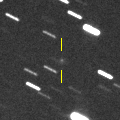
|
Now it is 17.1 mag (Oct. 8, Thomas Lehmann). It will brightens rapidly. And it is expected to be observable at 12-13 mag in good condition from December to February. However, it is much fainter than this ephemeris recently.
Date(TT) R.A. (2000) Decl. Delta r Elong. m1 Best Time(A, h)
Oct. 16 21 41.20 -7 52.7 0.770 1.550 122 15.7 20:01 ( 0, 47)
Oct. 23 21 41.52 -8 47.2 0.768 1.493 115 15.4 19:34 ( 0, 46)
|

|
Now it is 15.8 mag (Oct. 4, Thomas Lehmann). Now it is not observable. It will appear in the morning sky at 15 mag in January. Then it will brighten up to 13 mag in 2022 summer.
Date(TT) R.A. (2000) Decl. Delta r Elong. m1 Best Time(A, h)
Oct. 16 14 45.63 -14 51.6 4.210 3.299 20 15.5 18:48 ( 75, -5)
Oct. 23 14 55.36 -15 44.4 4.228 3.287 16 15.4 18:40 ( 76, -7)
|
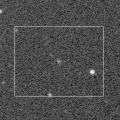
|
Now it is 16.2 mag (Oct. 1, Thomas Lehmann). It will brighten up to 12.5 mag in 2022 summer. In the Southern Hemisphere, it stays observable in excellent condition for a long time. In the Northern Hemisphere, it is not observable until August in 2022.
Date(TT) R.A. (2000) Decl. Delta r Elong. m1 Best Time(A, h)
Oct. 16 2 11.61 -75 25.8 4.162 4.371 95 15.5 0:35 ( 0,-20)
Oct. 23 1 34.20 -76 14.6 4.167 4.325 92 15.5 23:22 ( 0,-21)
|
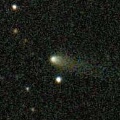
|
Now it is 14.8 mag (Oct. 3, Michael Jager). It stays 15 mag until October, and it is observable in good condition.
Date(TT) R.A. (2000) Decl. Delta r Elong. m1 Best Time(A, h)
Oct. 16 23 2.53 -17 11.2 1.479 2.307 136 15.6 21:22 ( 0, 38)
Oct. 23 23 3.58 -17 16.7 1.544 2.313 129 15.7 20:56 ( 0, 38)
|
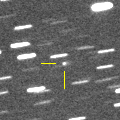
|
It brightened rapidly. Now it is 15.5 mag (Oct. 14, Sandor Szabo). It will be observable at 15 mag in excellent condition in winter.
Date(TT) R.A. (2000) Decl. Delta r Elong. m1 Best Time(A, h)
Oct. 16 8 4.54 23 12.4 2.348 2.456 84 15.7 4:42 (290, 64)
Oct. 23 8 13.08 22 26.0 2.263 2.456 89 15.6 4:48 (300, 68)
|
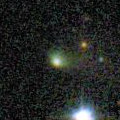
|
Now it is 15.5 mag (Oct. 14, Sandor Szabo). It continues brightening even after the perihelion passage. It may stay 15-16 mag for a while.
Date(TT) R.A. (2000) Decl. Delta r Elong. m1 Best Time(A, h)
Oct. 16 1 1.40 -14 23.9 2.013 2.952 156 15.6 23:20 ( 0, 41)
Oct. 23 0 58.62 -14 43.1 2.077 2.987 151 15.8 22:50 ( 0, 40)
|
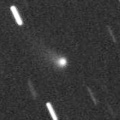
|
Now it is 15.9 mag (Sept. 24, D. Buczynski). In the Northern Hemisphere, it stays observable at 15-16 mag for a long time until early 2022, although it becomes extremely low temporarily from September to October. In the Southern Hemisphere, it is not observable until the end of 2021.
Date(TT) R.A. (2000) Decl. Delta r Elong. m1 Best Time(A, h)
Oct. 16 13 1.17 26 9.4 3.815 3.057 35 15.7 4:42 (243, 7)
Oct. 23 13 4.74 24 36.7 3.799 3.071 37 15.7 4:48 (248, 12)
|
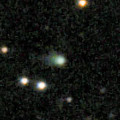
|
Now it is 15.7 mag (Oct. 2, Toshihiko Ikemura, Hirohisa Sato). It is expected to brighten up to 11 mag in 2023. In the Northern Hemisphere, it stays observable in good condition for a long time. It is not observable in the Southern Hemisphere.
Date(TT) R.A. (2000) Decl. Delta r Elong. m1 Best Time(A, h)
Oct. 16 16 7.97 35 29.7 6.271 5.818 58 15.7 18:48 (111, 38)
Oct. 23 16 9.67 34 38.0 6.262 5.775 56 15.7 18:40 (111, 34)
|
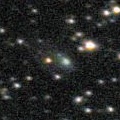
|
Now it is 15.4 mag (Oct. 1, Toshihiko Ikemura, Hirohisa Sato). It is expected to brighten up to 11 mag from spring to summer in 2022. In the Southen Hemisphere, it locates somewhat low in 2021, but it will be observable in good condition at the high light for a long time. In the Northern Hemisphere, it is observable in good condition in 2021, but it will not be observable at the high light.
Date(TT) R.A. (2000) Decl. Delta r Elong. m1 Best Time(A, h)
Oct. 16 18 35.34 11 9.6 3.392 3.366 80 15.9 18:48 ( 54, 55)
Oct. 23 18 35.87 8 57.5 3.436 3.302 73 15.9 18:40 ( 57, 50)
|
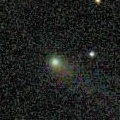
|
Now it is 16.0 mag (Oct. 8, Toshihiko Ikemura, Hirohisa Sato). It stays observable in good condition for a long time. But it will be fading after this.
Date(TT) R.A. (2000) Decl. Delta r Elong. m1 Best Time(A, h)
Oct. 16 22 55.14 1 44.1 1.325 2.201 142 15.9 21:15 ( 0, 57)
Oct. 23 22 54.79 2 3.1 1.386 2.210 135 16.0 20:47 ( 0, 57)
|
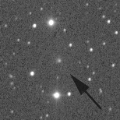
|
It brightened up to 14.2 mag in early summer (June 10, Thomas Lehmann). Now it is fading. In the Northern Hemisphere, it is appearing in the morning sky. In the Southern Hemisphere, it will never be observable again.
Date(TT) R.A. (2000) Decl. Delta r Elong. m1 Best Time(A, h)
Oct. 16 12 37.89 26 6.9 2.986 2.265 36 15.9 4:42 (246, 11)
Oct. 23 12 53.76 27 8.9 2.967 2.307 40 16.0 4:48 (247, 15)
|
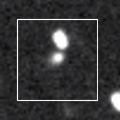
|
Now it is 16.6 mag (July 29, Thomas Lehmann). It is expected to brighten up to 10 mag in 2023. In the Northern Hemisphere, it stays observable in good condition until 2023 autumn, although it became extremely low temporarily in September. In the Southern Hemipshere, it stays unobservable until 2023 summer.
Date(TT) R.A. (2000) Decl. Delta r Elong. m1 Best Time(A, h)
Oct. 16 12 36.16 33 51.6 6.782 6.106 44 16.0 4:42 (239, 16)
Oct. 23 12 39.87 34 0.2 6.668 6.051 48 15.9 4:48 (243, 21)
|
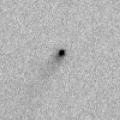
|
Now it is 16.0 mag (Oct. 1, Toshihiko Ikemura, Hirohisa Sato). It will be fading after this, and it will be fainter than 18 mag in December. In the Northern Hemisphere, it stays observable in good condition for a long time. It locates extremely low in the Southern Hemisphere.
Date(TT) R.A. (2000) Decl. Delta r Elong. m1 Best Time(A, h)
Oct. 16 7 59.10 32 34.8 1.361 1.649 87 16.0 4:42 (270, 69)
Oct. 23 8 15.40 33 45.8 1.332 1.677 91 16.2 4:48 (269, 73)
|
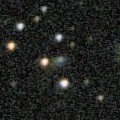
|
Now it is 17.5 mag (Oct. 10, Toshihiko Ikemura, Hirohisa Sato). It will brighten up to 15.5 mag in winter. In the Northern Hemisphere, it stays observable in good condition for a long time. It is not observable at all in the Southern Hemisphere.
Date(TT) R.A. (2000) Decl. Delta r Elong. m1 Best Time(A, h)
Oct. 16 15 38.73 63 29.7 3.223 3.147 76 16.2 18:48 (147, 39)
Oct. 23 15 40.49 62 51.3 3.190 3.124 77 16.2 18:40 (146, 37)
|
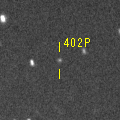
|
First return of a new periodic comet observed at 16 mag from 2003 to 2004. Now it is 17.0 mag (Sept. 27, ATLAS-MLO, Mauna Loa). It will brighten up to 16 mag in winter, and it will be observable in excellent condition.
Date(TT) R.A. (2000) Decl. Delta r Elong. m1 Best Time(A, h)
Oct. 16 6 38.41 1 4.2 3.635 3.953 101 16.3 4:42 (352, 56)
Oct. 23 6 40.17 0 54.7 3.539 3.949 107 16.2 4:35 ( 0, 56)
|
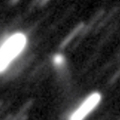
|
Now it is 15.8 mag (Oct. 2, Toshihiko Ikemura, Hirohisa Sato). It will be unobservable in November.
Date(TT) R.A. (2000) Decl. Delta r Elong. m1 Best Time(A, h)
Oct. 16 16 52.21 -8 20.6 5.434 4.877 51 16.2 18:48 ( 60, 23)
Oct. 23 16 56.91 -7 55.8 5.517 4.881 46 16.3 18:40 ( 63, 21)
|
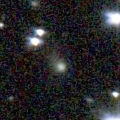
|
Now it is 16.2 mag (Oct. 1, Toshihiko Ikemura, Hirohisa Sato). It is expected to brighten up to 11 mag in 2023. In the Northern Hemisphere, it is observable in good condition in 2021. But it is observable only until November in 2022. In the Southern Hemisphere, it locates extremely low in 2021. But it will be observable in good condition at the high light.
Date(TT) R.A. (2000) Decl. Delta r Elong. m1 Best Time(A, h)
Oct. 16 17 31.46 28 13.6 6.266 6.004 70 16.3 18:48 ( 92, 52)
Oct. 23 17 34.16 27 0.7 6.282 5.956 66 16.3 18:40 ( 93, 48)
|
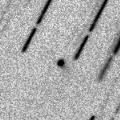
|
Michael Jager detected its cometary activity on Sept. 25. Now it is bright as 16.2 mag (Oct. 3, Michael Jager). It approaches to Earth down to 0.35 a.u. in early October, and it is observable at 16 mag in excellent condition.
Date(TT) R.A. (2000) Decl. Delta r Elong. m1 Best Time(A, h)
Oct. 16 0 22.74 -1 53.4 0.372 1.355 161 16.3 22:43 ( 0, 53)
Oct. 23 0 36.26 -6 36.7 0.397 1.364 154 16.6 22:29 ( 0, 48)
|
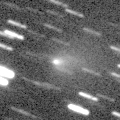
|
Outburst occured in early August, and it brightened up to 14.1 mag (Aug. 7, Michael Jager). Now it is fading. It has already faded down to 17.5 mag (Oct. 8, Toshihiko Ikemura, Hirohisa Sato). In the Northern Hemisphere, it stays observable in good condition. In the Southern Hemipsphere, it stays locating extremely low after this.
Date(TT) R.A. (2000) Decl. Delta r Elong. m1 Best Time(A, h)
Oct. 16 5 59.20 46 42.2 2.194 2.712 110 16.4 4:22 (180, 78)
Oct. 23 6 0.15 47 22.0 2.146 2.742 116 16.6 3:56 (180, 78)
|
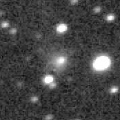
|
Now it is 16.2 mag (Oct. 7, Thomas Lehmann). It is observable at 16 mag from 2020 to 2021. It locates low in the Southern Hemisphere.
Date(TT) R.A. (2000) Decl. Delta r Elong. m1 Best Time(A, h)
Oct. 16 21 37.73 31 54.5 5.557 6.157 122 16.5 19:57 ( 0, 87)
Oct. 23 21 34.94 30 18.7 5.636 6.170 118 16.5 19:27 ( 0, 85)
|
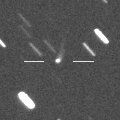
|
It was expected to brighten up to 14.5 mag from spring to summer. But actually, it is fainter than expected. Now it is 16.4 mag (Oct. 4, ATLAS-MLO, Mauna Loa). In the Southern Hemisphere, it stays observable for a long time. In the Northern Hemisphere, it is not observable after this.
Date(TT) R.A. (2000) Decl. Delta r Elong. m1 Best Time(A, h)
Oct. 16 11 36.05 -51 32.0 3.798 3.219 48 16.5 4:42 (319,-21)
Oct. 23 11 42.35 -51 33.4 3.843 3.260 47 16.6 4:48 (322,-17)
|

|
It brightened up to 11.6 mag in winter (Feb. 18, Thomas Lehmann). Now it is fading. It has already faded down to 15.8 mag (Sept. 15, Thomas Lehmann). In the Southern Hemisphere, it stays observable in good condition after this. In the Northern Hemisphere, it will never be observable after this.
Date(TT) R.A. (2000) Decl. Delta r Elong. m1 Best Time(A, h)
Oct. 16 3 35.35 -70 26.8 3.843 4.097 97 16.5 1:58 ( 0,-15)
Oct. 23 3 9.68 -70 26.4 3.919 4.161 97 16.6 1:05 ( 0,-15)
|
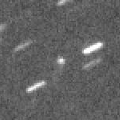
|
Now it is 17.0 mag (Oct. 2, Toshihiko Ikemura, Hirohisa Sato). It will brighten up to 16 mag in 2022. In the Northern Hemisphere, it stays observable in good condition for a long time. In the Southern Hemisphere, it is not observable until 2023.
Date(TT) R.A. (2000) Decl. Delta r Elong. m1 Best Time(A, h)
Oct. 16 9 7.99 59 16.6 4.095 4.125 84 16.7 4:42 (215, 54)
Oct. 23 9 16.87 61 16.6 3.981 4.101 89 16.6 4:48 (210, 55)
|
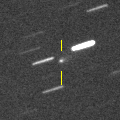
|
Now it is 16.6 mag (Oct. 8, Toshihiko Ikemura, Hirohisa Sato). It stays observable at 17 mag from autumn to winter. In the Northern Hemisphere, it stays observable in good condition. In the Southern Hemisphere, it stays extremely low until November.
Date(TT) R.A. (2000) Decl. Delta r Elong. m1 Best Time(A, h)
Oct. 16 10 12.41 16 10.4 2.184 1.780 53 16.7 4:42 (274, 35)
Oct. 23 10 28.67 14 17.5 2.139 1.785 56 16.7 4:48 (279, 38)
|
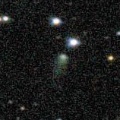
|
Now it is 16.6 mag (Oct. 3, Toshihiko Ikemura, Hirohisa Sato). It stays at 16-17 mag from 2020 to 2021. In the Northern Hemisphere, it stays observable in good condition for a long time. In the Southern Hemisphere, it is not observable after this.
Date(TT) R.A. (2000) Decl. Delta r Elong. m1 Best Time(A, h)
Oct. 16 18 19.79 48 19.6 8.923 8.913 86 16.8 18:48 (129, 63)
Oct. 23 18 20.66 47 58.9 8.966 8.919 84 16.8 18:40 (127, 60)
|
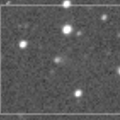
|
First return of a new periodic comet which brightened up to 17 mag in 2006. Now it is 17.4 mag (Sept. 27, N. Paul, E. Cortes). It stays 17 mag from 2021 to 2022.
Date(TT) R.A. (2000) Decl. Delta r Elong. m1 Best Time(A, h)
Oct. 16 21 32.11 -59 59.5 2.878 3.167 97 16.8 19:53 ( 0, -5)
Oct. 23 21 35.61 -58 6.6 2.934 3.158 93 16.8 19:29 ( 0, -3)
|
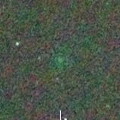
|
It brightened up to 4 mag in major outburst in 2016. In this apparition, it brightened up to 10.5 mag in early August (Aug. 8, Rob Kaufman). Now it is fading rapidly. It has already faded down to 14.0 mag (Aug. 31, Chris Wyatt). In the Southern Hemisphere, it stays locating low in the evening sky until October. In the Northern Hemisphere, it stays locating extremely low.
Date(TT) R.A. (2000) Decl. Delta r Elong. m1 Best Time(A, h)
Oct. 16 15 52.35 -13 12.3 2.293 1.610 36 16.9 18:48 ( 67, 9)
Oct. 23 16 13.19 -14 5.5 2.386 1.672 35 17.5 18:40 ( 66, 9)
|
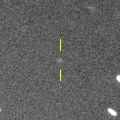
|
Now it is 16.4 mag (Sept. 27, ATLAS-MLO, Mauna Loa). It continues brightening even after the perihelion passage. It stays observable at 17 mag in good condition for a while.
Date(TT) R.A. (2000) Decl. Delta r Elong. m1 Best Time(A, h)
Oct. 16 5 11.26 -14 31.2 3.127 3.713 118 16.9 3:34 ( 0, 41)
Oct. 23 5 9.73 -15 7.5 3.084 3.731 123 16.9 3:05 ( 0, 40)
|

|
Now it is 17.7 mag (May 12, ATLAS-HKO, Haleakala). It brightened rapidly. It stays 17 mag for a long time from 2021 to 2022. In the Southern Hemisphere, it stays observable in good condition for a long time. In the Northern Hemisphere, it will be observable only in extremely low sky from autumn to winter.
Date(TT) R.A. (2000) Decl. Delta r Elong. m1 Best Time(A, h)
Oct. 16 9 8.64 -26 44.9 5.721 5.336 62 17.0 4:42 (321, 16)
Oct. 23 9 9.14 -28 19.8 5.639 5.335 67 16.9 4:48 (329, 19)
|
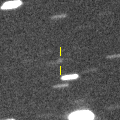
|
Now it is 17.3 mag (Oct. 2, Toshihiko Ikemura, Hirohisa Sato). It will brighten up to 15.5 mag, and will be observable in excellent condition in winter.
Date(TT) R.A. (2000) Decl. Delta r Elong. m1 Best Time(A, h)
Oct. 16 9 27.74 14 21.1 2.264 2.014 62 17.1 4:42 (284, 43)
Oct. 23 9 42.43 13 26.9 2.196 2.011 66 16.9 4:48 (289, 46)
|
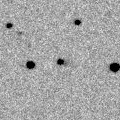
|
Now it is 15.6 mag (Oct. 13, Sandor Szabo). It is observable at 16-17 mag in good condition in autumn. It is brighter than this ephemeris recently.
Date(TT) R.A. (2000) Decl. Delta r Elong. m1 Best Time(A, h)
Oct. 16 2 23.49 16 33.3 2.835 3.801 163 17.1 0:47 ( 0, 72)
Oct. 23 2 20.26 15 56.8 2.813 3.799 171 17.0 0:16 ( 0, 71)
|

|
Now it is 17.1 mag (Oct. 2, Toshihiko Ikemura, Hirohisa Sato). It will brighten rapidly, and it will be observable at 13.5 mag in good condition from winter to spring.
Date(TT) R.A. (2000) Decl. Delta r Elong. m1 Best Time(A, h)
Oct. 16 9 5.82 20 9.3 3.027 2.838 69 17.2 4:42 (281, 51)
Oct. 23 9 14.86 19 36.1 2.913 2.813 74 17.1 4:48 (287, 55)
|
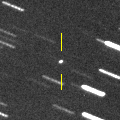
|
Now it is 16.7 mag (Oct. 2, Toshihiko Ikemura, Hirohisa Sato). In the Northern Hemisphere, it stays observable in good condition after this while the comet will be fading. In the Southern Hemisphere, it stays locating extremely low for a long time.
Date(TT) R.A. (2000) Decl. Delta r Elong. m1 Best Time(A, h)
Oct. 16 5 26.34 41 8.7 2.263 2.866 117 17.2 3:49 (180, 84)
Oct. 23 5 23.86 41 44.9 2.241 2.921 124 17.2 3:19 (180, 83)
|
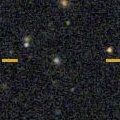
|
Now it is 17.5 mag (Oct. 1, Toshihiko Ikemura, Hirohisa Sato). It is expected to brighten up to 4.5 mag in 2022 April. However, it is not observable at the high light. In the Northern Hemisphere, it stays observable until early February when it brightens up to 14 mag. Then it will appear at 6 mag in mid May, and it stays observable in good condition after that while the comet will be fading. In the Southern Hemisphere, it stays observable until December when it brightens up to 16 mag. But after that, it is not observable until 2022 August.
Date(TT) R.A. (2000) Decl. Delta r Elong. m1 Best Time(A, h)
Oct. 16 22 10.27 18 57.2 2.584 3.336 132 17.3 20:30 ( 0, 74)
Oct. 23 22 4.84 17 8.6 2.567 3.246 125 17.2 19:57 ( 0, 72)
|

|
Now it is 18.4 mag (Oct. 2, Toshihiko Ikemura, Hirohisa Sato). It stays 17-18 mag for a long time from 2021 to 2022. It is observable in excellent condition in the Northern Hemisphere, It locates somewhat low in the Southern Hemisphere.
Date(TT) R.A. (2000) Decl. Delta r Elong. m1 Best Time(A, h)
Oct. 16 5 8.96 34 8.4 4.906 5.507 122 17.3 3:32 ( 0, 89)
Oct. 23 5 0.62 34 20.6 4.792 5.495 130 17.2 2:56 ( 0, 89)
|
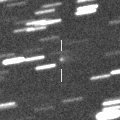
|
Now it is 17.2 mag (Sept. 20, Ken-ichi Kadota). In the Northern Hemisphere, it stays observable at 17 mag in good condition until winter. In the Southern Hemisphere, it stays locating extremely low for a while.
Date(TT) R.A. (2000) Decl. Delta r Elong. m1 Best Time(A, h)
Oct. 16 8 37.68 30 8.2 2.023 2.073 78 17.3 4:42 (270, 61)
Oct. 23 8 48.15 28 59.5 1.973 2.099 83 17.3 4:48 (276, 65)
|
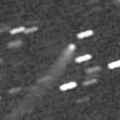
|
Now it is 17.1 mag (Oct. 3, Toshihiko Ikemura, Hirohisa Sato). Fading slowly. In the Northern Hemisphere, it stays observable in good condition for a long time. It is not observable after this in the Southern Hemisphere.
Date(TT) R.A. (2000) Decl. Delta r Elong. m1 Best Time(A, h)
Oct. 16 16 17.60 48 36.1 6.186 5.901 68 17.3 18:48 (127, 43)
Oct. 23 16 20.00 48 12.4 6.234 5.936 68 17.4 18:40 (127, 40)
|

|
Now it is 18.4 mag (Oct. 10, Toshihiko Ikemura, Hirohisa Sato). It will brighten up to 16.5-17 mag in winter. In its last apparition in 2015, it brightened up to 13 mag.
Date(TT) R.A. (2000) Decl. Delta r Elong. m1 Best Time(A, h)
Oct. 16 21 44.76 -32 44.4 1.550 2.151 113 17.5 20:05 ( 0, 22)
Oct. 23 21 46.92 -32 15.4 1.586 2.110 107 17.4 19:40 ( 0, 23)
|
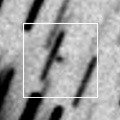
|
Now it is 17.6 mag (Oct. 10, Toshihiko Ikemura, Hirohisa Sato). It is expected to brighten up to 11 mag in 2022 summer. In the Northern Hemisphere, it stays observable in good condition until 2022 June when it brightens up to 11 mag. But it is not observable after the high light. In the Souther Hemisphere, it is not observable until 2022 October.
Date(TT) R.A. (2000) Decl. Delta r Elong. m1 Best Time(A, h)
Oct. 16 23 32.98 63 11.6 3.362 3.982 122 17.6 21:51 (180, 62)
Oct. 23 23 18.81 62 46.1 3.291 3.910 121 17.5 21:10 (180, 62)
|

|
First return of a new periodic comet which brightened up to 17 mag in 2011. Now it is 17.2 mag (Sept. 16, Catalina Sky Survey). It stays observable at 17 mag in good condition until 2022 spring.
Date(TT) R.A. (2000) Decl. Delta r Elong. m1 Best Time(A, h)
Oct. 16 10 12.65 14 35.1 2.016 1.621 52 17.6 4:42 (276, 34)
Oct. 23 10 32.56 12 52.2 1.960 1.603 54 17.5 4:48 (280, 36)
|
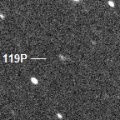
|
Now it is 17.1 mag (Oct. 2, Toshihiko Ikemura, Hirohisa Sato). It will brighten up to 15 mag in 2022 winter. In 2021, it stays observable in good condition while the comet will be brightening gradually.
Date(TT) R.A. (2000) Decl. Delta r Elong. m1 Best Time(A, h)
Oct. 16 22 23.34 -19 9.9 2.329 3.041 127 17.5 20:43 ( 0, 36)
Oct. 23 22 22.58 -19 3.4 2.385 3.016 120 17.5 20:15 ( 0, 36)
|
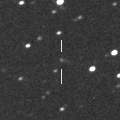
|
Now it is 17.4 mag (Sept. 29, ATLAS-HKO, Haleakala). It will brighten up to 14 mag in early 2023. It stays observable in good condition for a long time until spring.
Date(TT) R.A. (2000) Decl. Delta r Elong. m1 Best Time(A, h)
Oct. 16 4 54.53 3 16.0 4.786 5.448 127 17.8 3:17 ( 0, 58)
Oct. 23 4 53.49 3 2.7 4.667 5.403 133 17.7 2:49 ( 0, 58)
|

|
Peculiar asteroid moving along a cometary orbit. It brightens up to 17 mag from September to October. In the Northern Hemisphere, it is observable in excellent condition. It is not observable in the Southern Hemisphere.
Date(TT) R.A. (2000) Decl. Delta r Elong. m1 Best Time(A, h)
Oct. 16 21 15.60 77 36.9 0.774 1.406 104 17.8 19:34 (180, 48)
Oct. 23 21 20.13 71 47.5 0.878 1.514 107 18.1 19:12 (180, 53)
|
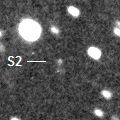
|
First return of a new periodic comet which brightened up to 17 mag in 2012. Now it is 18.0 mag (Sept. 26, ATLAS-MLO, Mauna Loa). It is observable in excellent condition in the Southern Hemisphere. It locates low in the Northern Hemisphere.
Date(TT) R.A. (2000) Decl. Delta r Elong. m1 Best Time(A, h)
Oct. 16 20 50.35 -32 10.7 0.748 1.376 103 17.8 19:12 ( 0, 23)
Oct. 23 21 10.07 -29 38.5 0.762 1.367 101 17.8 19:04 ( 0, 26)
|
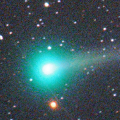
|
It brightened up to 3 mag in December in the SOHO spacecraft images in 2020 December (Dec. 18, Hirohisa Sato). Now it is 17.6 mag (Oct. 1, Toshihiko Ikemura, Hirohisa Sato). It stays observable in good condition after this while the comet will be fading.
Date(TT) R.A. (2000) Decl. Delta r Elong. m1 Best Time(A, h)
Oct. 16 23 13.61 13 26.8 3.757 4.631 147 17.8 21:33 ( 0, 69)
Oct. 23 23 10.31 12 38.1 3.891 4.706 141 17.9 21:02 ( 0, 68)
|
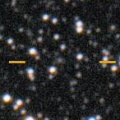
|
Now it is 17.4 mag (Oct. 2, Toshihiko Ikemura, Hirohisa Sato). It stays observable at 17-18 mag for a long time from 2021 to 2022.
Date(TT) R.A. (2000) Decl. Delta r Elong. m1 Best Time(A, h)
Oct. 16 19 19.29 -18 53.7 4.027 4.084 86 17.8 18:48 ( 19, 34)
Oct. 23 19 24.22 -18 48.2 4.127 4.081 80 17.8 18:40 ( 23, 33)
|
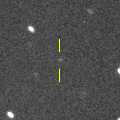
|
Now it is 18.1 mag (Oct. 2, Toshihiko Ikemura, Hirohisa Sato). It has passed the perihelion in 2020 October. At the discovery in 2005, it stayed bright for several years even after the perihelion passage. In this apparition, it may stay observable at 18 mag from 2021 to 2024.
Date(TT) R.A. (2000) Decl. Delta r Elong. m1 Best Time(A, h)
Oct. 16 23 17.83 -29 17.8 3.319 4.048 131 17.9 21:37 ( 0, 26)
Oct. 23 23 16.19 -28 59.0 3.414 4.070 125 17.9 21:08 ( 0, 26)
|
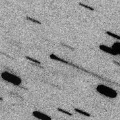
|
Now it is 18.1 mag (Oct. 3, Michael Jager). Main-belt asteroid, but it has a long tail of 10 arcmin. It stays observable in good condition until winter.
Date(TT) R.A. (2000) Decl. Delta r Elong. m1 Best Time(A, h)
Oct. 16 23 37.76 -2 25.5 1.585 2.506 151 19.7 21:57 ( 0, 53)
Oct. 23 23 35.34 -2 41.3 1.645 2.518 143 19.9 21:27 ( 0, 52)
|
|
![]()
 28P/Neujmin 1
28P/Neujmin 1 C/2021 O3 ( PanSTARRS )
C/2021 O3 ( PanSTARRS ) C/2020 U4 ( PanSTARRS )
C/2020 U4 ( PanSTARRS ) 241P/LINEAR
241P/LINEAR C/2019 K7 ( Smith )
C/2019 K7 ( Smith ) 230P/LINEAR
230P/LINEAR C/2021 P4 ( ATLAS )
C/2021 P4 ( ATLAS ) 430P/2021 Q2 ( Scotti )
430P/2021 Q2 ( Scotti ) 119P/Parker-Hartley
119P/Parker-Hartley C/2020 S4 ( PanSTARRS )
C/2020 S4 ( PanSTARRS ) 2012 US136
2012 US136 424P/2021 L5 ( La Sagra )
424P/2021 L5 ( La Sagra ) C/2020 S3 ( Erasmus )
C/2020 S3 ( Erasmus ) 395P/2020 H1 ( Catalina-NEAT )
395P/2020 H1 ( Catalina-NEAT ) 378P/2019 E2 ( McNaught )
378P/2019 E2 ( McNaught ) 433P/(248370) 2005 QN173
433P/(248370) 2005 QN173![]()







































































